Technologies
PSVR 2: Price, Games and Everything You Need to Know
The Sony PSVR 2 headset is on sale now for $550. We’ve reviewed it and played its games. Here’s what you need to know.
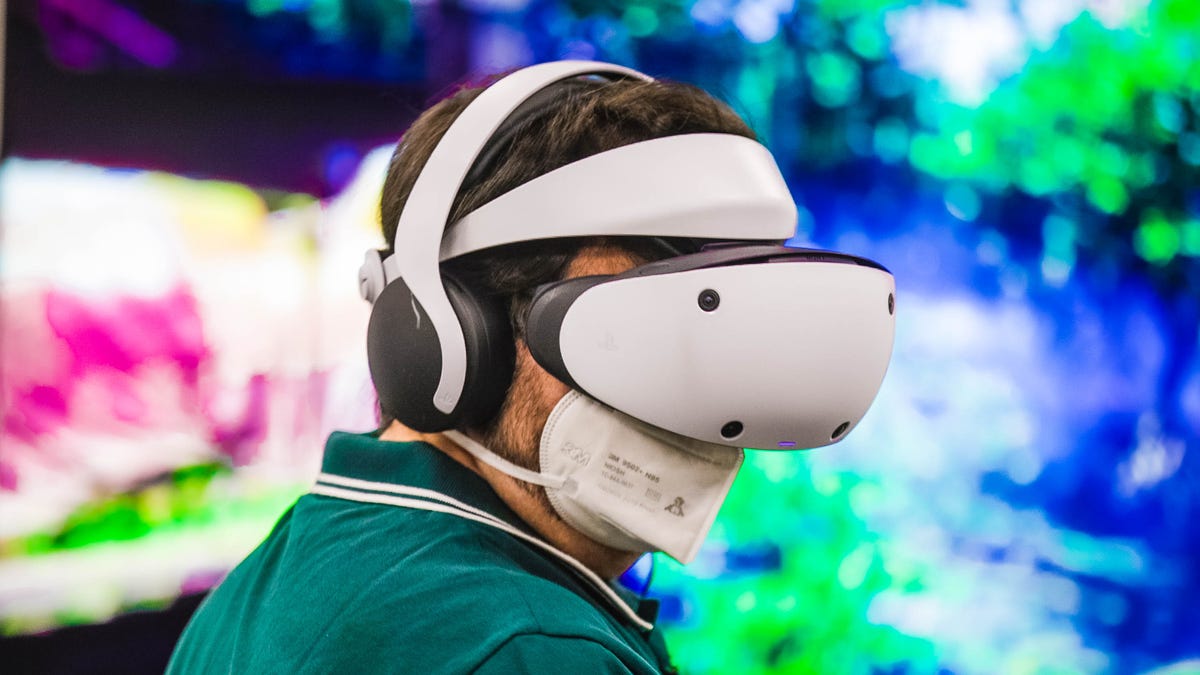
Sony’s first big accessory for the PlayStation 5, the PlayStation VR 2 headset, is here. We just reviewed it: It’s one of the best immersive gaming experiences we’ve ever had, and has some great games already, but it also costs more than the PlayStation 5 itself. Yeah, you read that right: The PSVR 2 costs $550. It’s expensive, but if you’re OK with tethering to a PlayStation 5 with a long cable, this could be the hardware for you, as opposed to waiting for the Meta Quest 3 or Apple’s expected VR headset.
The PSVR 2 isn’t wireless, but its higher-res HDR OLED display and advanced vibrating controllers, along with perks like eye tracking and in-headset rumble, give it a lot of hardware advantages. But its game library feels a little incomplete at the moment. If you’re interested in one, you might want to wait and see what other games arrive throughout the year.
Also, if you’re interested in comparing it to the Quest 2 (the most popular VR headset of the last few years), we’ve got you covered there too.
Sony has a whole FAQ library for tips and advice on the PSVR 2, which you should reference and dive into. Below are additional observations based on our time with it so far.


This is what comes inside the package: controllers, headset, earbuds and an extra USB-C-to-A cable.
Scott Stein/CNETWhat’s in the box?
The PSVR 2 retail package has a cabled headset, a pair of Sense controllers, a pair of earbuds that connect to a headphone jack on the headset and a USB-C-to-A cable for charging the controllers and to initially pair to the PS5. A $50 charging dock, which can optionally charge up both your controllers at once, is sold separately.
You need a PS5 to use it
The PSVR 2 isn’t a stand-alone, self-contained headset like Meta’s Quest 2 (also known as the Oculus Quest 2) or Quest Pro. That means you’ll need to tether it to a PlayStation 5 (and own a PS5) to use it.
The PlayStation VR 2 looks, in a lot of ways, like the headset we wanted for the PS5 all along. It’s a long-awaited update to the PlayStation VR that Sony released for the PlayStation 4 back in 2016: A new design with a color scheme that matches the PS5, and a headband-type visor that’s similar to but smaller than Sony’s first PSVR. The high-res, vibrating, camera-equipped, eye-tracking capabilities of Sony’s second-gen PlayStation headset look like they fit the top-end specs anyone would dream of. However, the new PSVR 2 isn’t automatically backward-compatible with all the older PSVR games — the games will need to be updated by their developer in order to work.
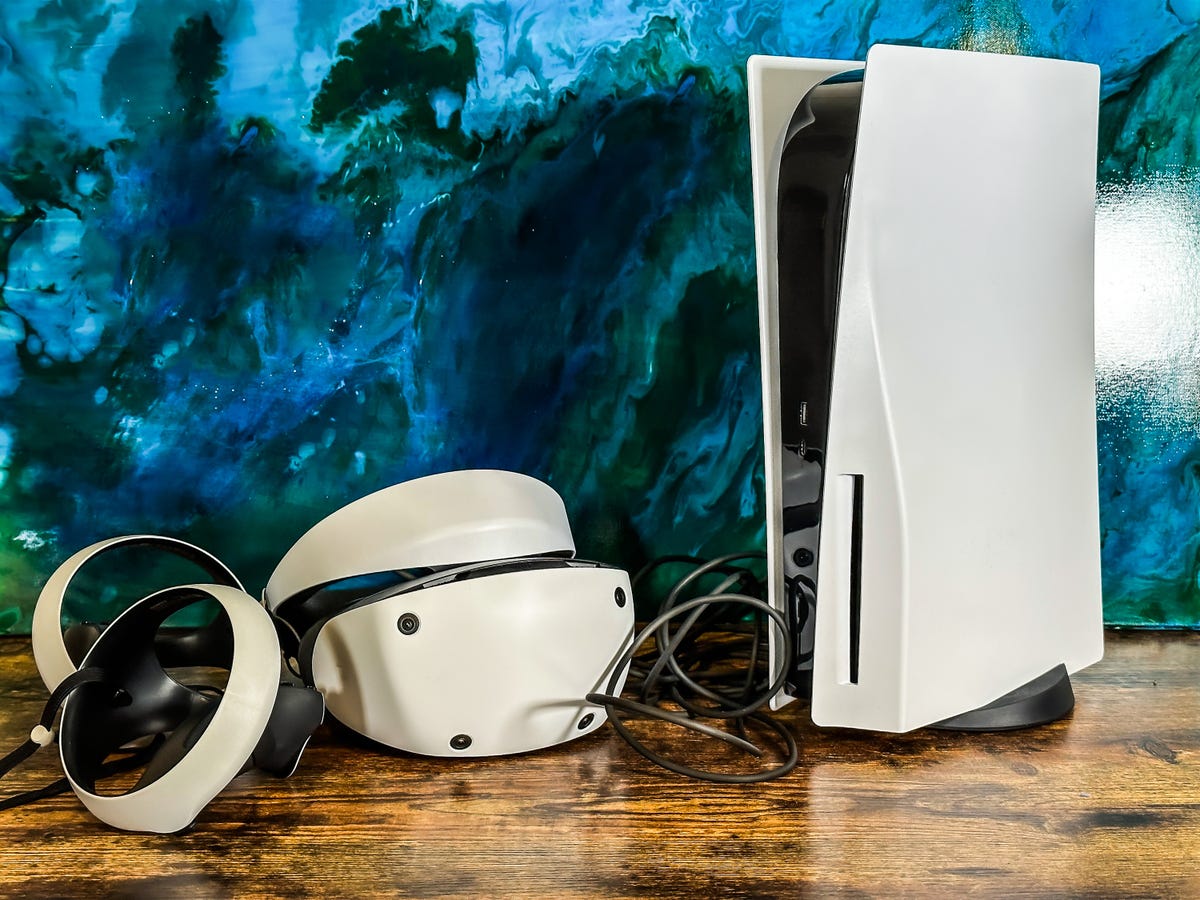

The PSVR 2 needs a PS5. It’s cabled to it. But once you’ve set it up, you don’t need a TV.
Scott Stein/CNETThe PSVR 2 works much like other VR headsets, but with greatly improved display technology, eye tracking and advanced vibrating haptics and triggers in the controllers and headset that make virtual objects feel more convincing.
The VR headset’s eye tracking also enables foveated rendering, a technology that focuses only on where the fovea of the eye is looking to maximize resolution, getting more graphics punch with fewer pixels. (Dominic Mallinson, Sony’s PlayStation head of R&D, suggested eye tracking could be likely back in a 2019 conversation with CNET.)
PSVR 2 can scan your room, live-broadcast VR gaming
Passthrough cameras on the headset work like cameras on the Quest 2 and other VR headsets, showing the real world in your headset. The headset will also «mesh» your physical space, scanning walls, floors and obstacles like chairs and desks to get a clear sense of play space. It can create a boundary you can play in.
The meshing part is particularly interesting, because it’s something AR headsets and mixed-reality headsets do. It means the PSVR 2 could, theoretically, also have some mixed reality experiences like the Quest 2 is already playing with, although Sony hasn’t announced anything on that front yet.
One unique feature is a live broadcast mode, which will use the PS5’s TV-mounted camera to record yourself overlaid with footage from your live gameplay into a single stream. Mixed reality livecasting tools have been emerging for Quest 2, but no game console has ever had this feature before.
There’s a cinematic mode plus a VR mode
Sony also details two display modes for the headset: one, for VR, will display at 2,000×2,040 pixels per eye in HDR, at 90Hz or 120Hz. A 2D «cinematic mode,» much like what the original PSVR can do, plays movies and 2D games at 1,920×1,080 resolution in HDR at either 24Hz, 60Hz or 120Hz.
Playing 2D games on the PSVR 2 does feel better than you’d think, but movies and TV shows don’t look as good as a large, nice TV (to our eyes). However, this means you could use the PSVR 2 as a self-contained gaming display for the PS5 to play games on while the TV is off or playing something else (or if there’s no TV at all, provided you already set up the PSVR 2 with a TV the first time).
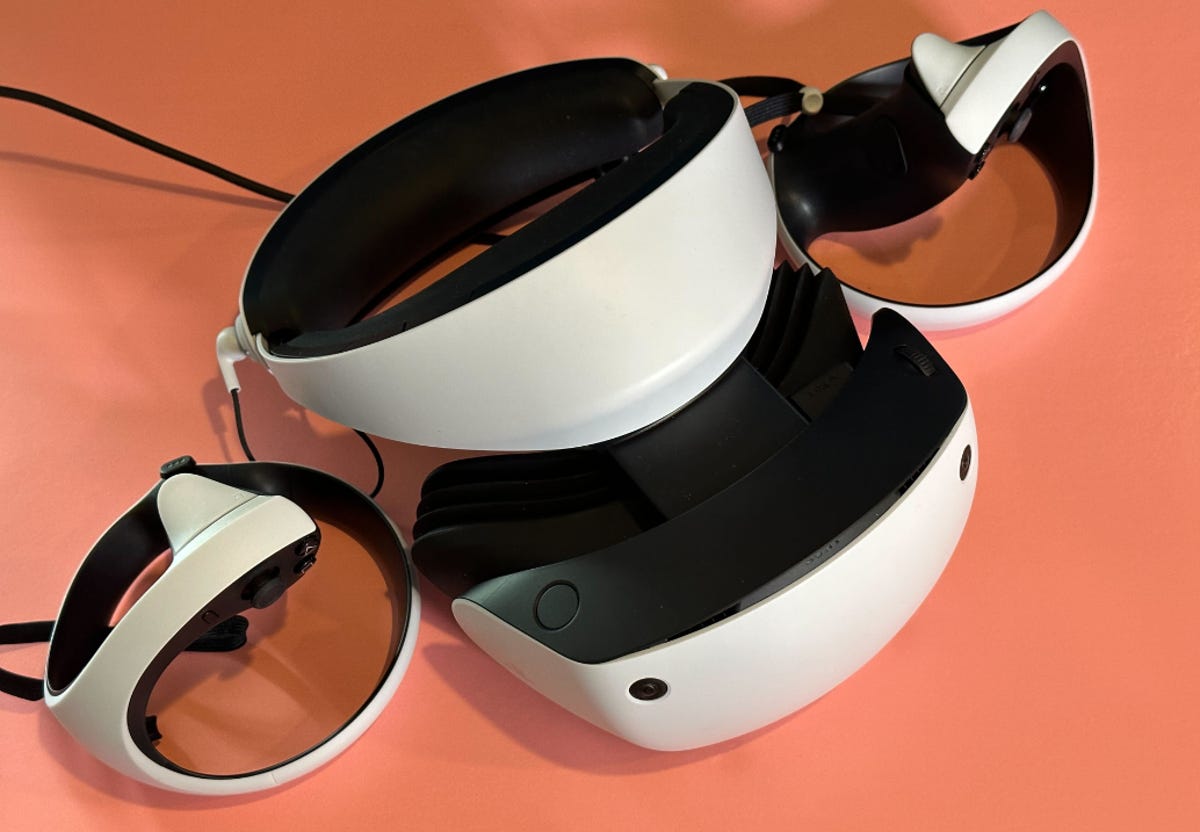

The PSVR 2 has a cable. You have to learn to live with it.
Scott Stein/CNETHeadset specs
- OLED displays, with 2,000×2,040-pixel resolution per eye, 90Hz and 120Hz frame rates
- 110-degree field of view
- Eye tracking and foveated rendering
- Adjustable lens separation
- In-headset vibration
- 3D audio
- Built-in microphone and audio-out headset jack
- Four external cameras for tracking
- Single USB-C connection
- Sense controllers with USB-C ports, Bluetooth 5.1, rechargeable batteries, 6DoF tracking, finger tracking using capacitive touch buttons and infrared, haptics and specialized haptic triggers like the DualSense controller
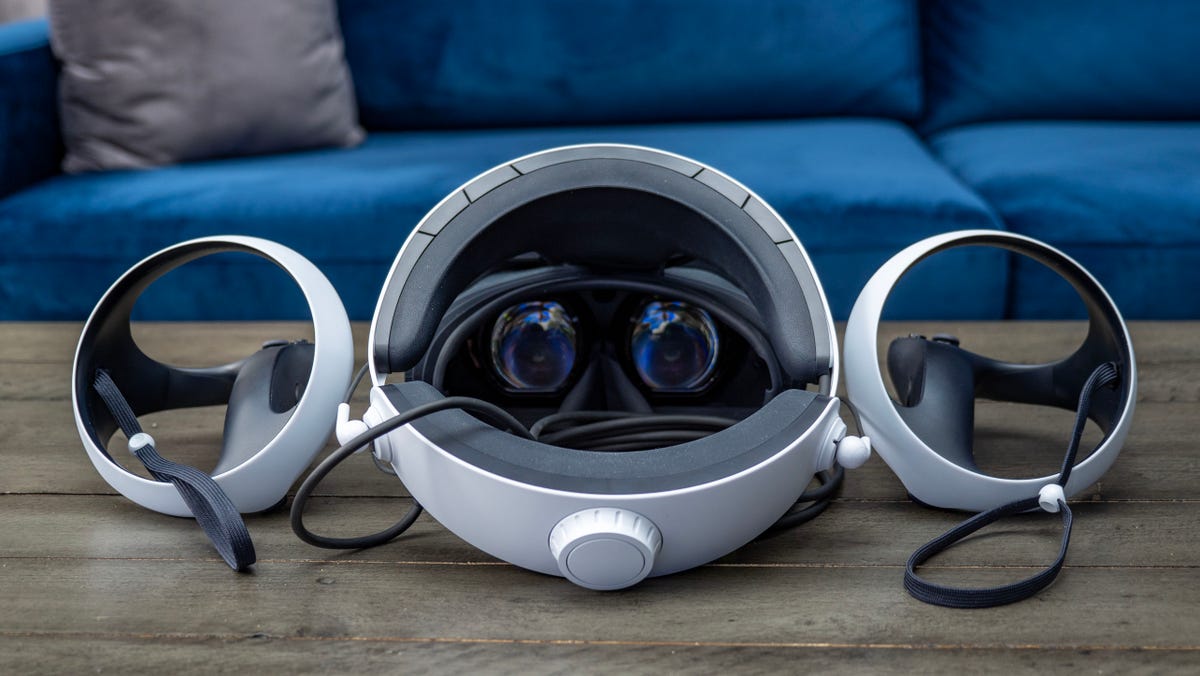

Eye tracking comes built in, via infrared cameras around the lenses.
Josh Goldman/CNETHeadset design: Vibrations, eye tracking, moving lenses
Even if Sony’s PSVR 2 headset looks bulky in the photos, it’s actually a lot more comfortable than the Quest 2. An adjustable headband, similar to the PSVR’s original design, means it’ll tighten around the head like a visor instead of using an elastic strap to squeeze your face. The headset can move closer to your face, and lens distance can be adjusted for different IPD levels (interpupillary distance, or the space between eyes). The headset also works really well for my glasses, fitting over my wide frames easily with soft rubberized sides to block out light, and the hardware feels comfortable over longer game sessions.
The headset supports headphones with a standard headphone jack, and has one cable that tethers to the PS5 via USB-C, via a jack that seems to come out of one side of the headband. That’s a lot fewer wires than the breakout box needed for the original PSVR. Included earbuds are fine, but there aren’t any ambient speakers like the Quest 2 has. You can connect Sony’s wireless Pulse headset, too, which sounds better.
Built-in eye tracking promises to deliver better graphics, and possibly allow eye control and eye contact in VR games. Eye tracking isn’t common in consumer VR headsets yet, but the technology should be arriving on other mainstream headsets, and possibly Apple’s as well. It worked well enough with my glasses.
The headset’s four tracking cameras allow movement in VR to be tracked without using a TV-connected camera bar. The tracking should work in a similar way to other VR headsets. It’s possible that the cameras could allow some pass-through mixed reality, too, blending VR with what the cameras see onto the headset’s display.
Some people have reported that the headset has a limited «sweet spot» to make things look good with their eyes, and I’ve seen it take some adjustment to get my eye/head fit just right. However, the headset still feels better over my glasses than other VR headsets with the exception of the Quest Pro.
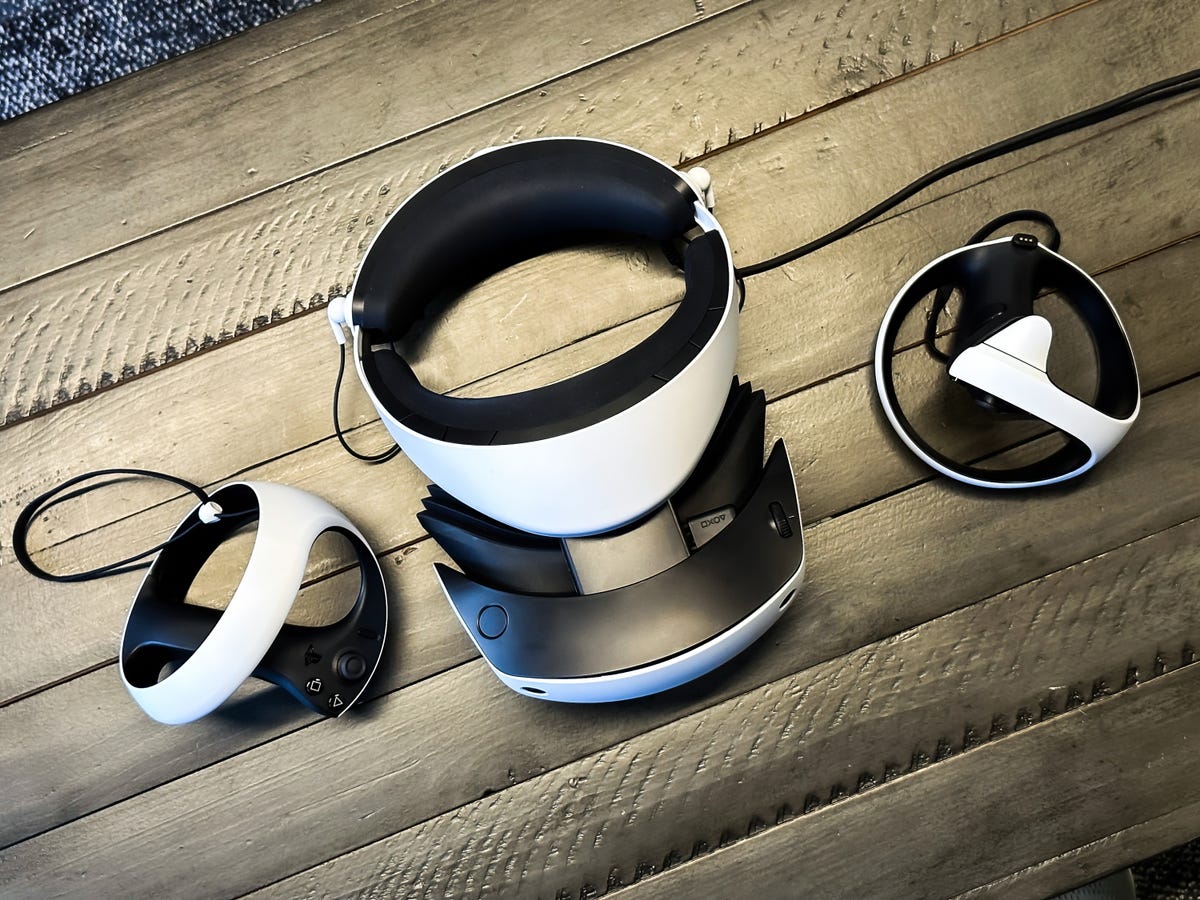

A look at the hardware from above.
Scott Stein/CNETHow long is the cable?
The USB-C cable attached to the PSVR 2 headset is about 15 feet long, long enough for us to comfortably move around a roughly 7-by-7-foot play space, which is about what Sony recommends for full-motion VR gaming. There are ways to play standing or sitting down, too, but much like other tethered VR headsets, that heavy cable can sometimes get tangled under your feet or around your legs.
Is the PSVR 2 eyeglasses-friendly?
Yes, very. I wear chunky glasses, and the wide headset fits over my glasses just fine. Your mileage may vary, but it felt like the best over-glasses fit of any VR headset around. Unlike the Quest 2 (which doesn’t accommodate all glasses sizes), the Quest Pro (which fits over wide glasses but can can be a bit stiff to take on and off), and some headsets like the Vive XR Elite that don’t work with glasses at all and use prescription adjustment instead, the easy-to-adjust visor design here was welcome.
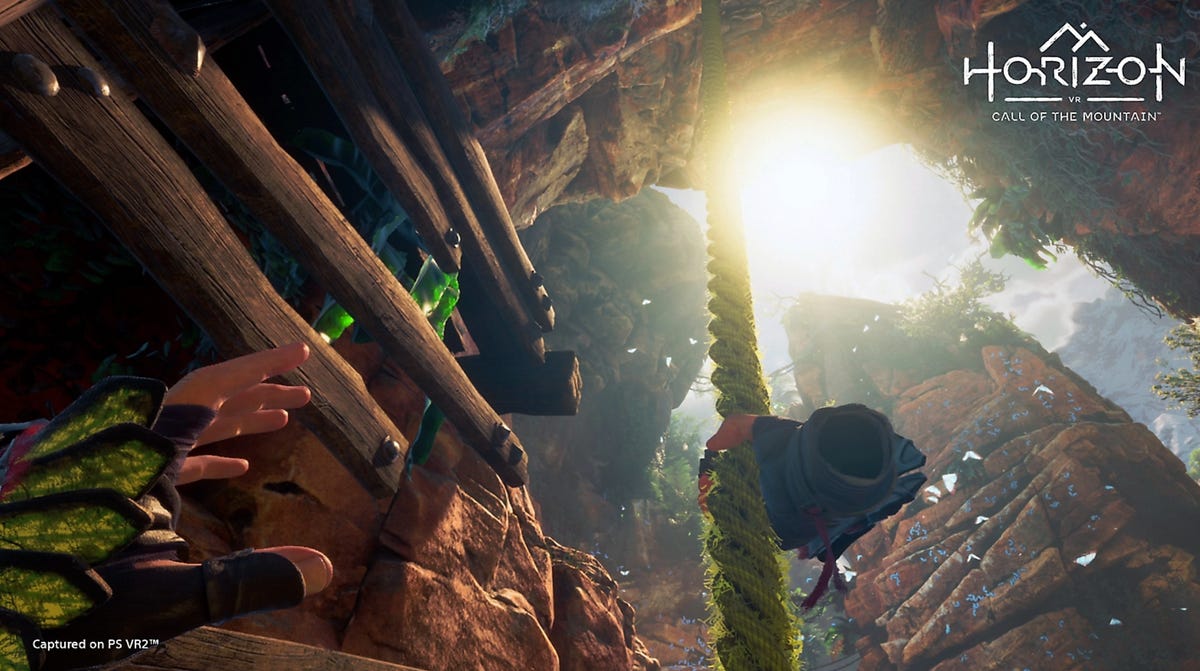

Horizon Call of the Mountain is one of the most eye-catching launch games, but its climbing and bow-and-arrow action might not be for everyone.
Sony Interactive EntertainmentLaunch games: Lots of options
Sony’s own exclusive, Horizon Call of the Mountain, remains the PSVR 2’s splashiest game, but other games have been announced as well. No Man’s Sky, The Walking Dead: Saints & Sinners — Chapter 2: Retribution, Resident Evil Village, Star Wars: Tales from the Galaxy’s Edge, Demeo and Gran Turismo 7 are some of the early standouts.
For more, check out CNET’s favorite PSVR 2 games so far.
However, some bad news for original PSVR owners: Sony confirmed that original PSVR games aren’t necessarily PSVR 2-compatible unless the games are specifically updated.
The games that are already here, or are announced already as coming in the future:
- Horizon Call of the Mountain
- Gran Turismo 7
- Resident Evil Village
- Puzzling Places
- What the Bat?
- Demeo
- Star Wars: Tales From the Galaxy’s Edge Enhanced Edition
- Moss and Moss Book II
- Firewall Ultra
- Creed: Rise to Glory
- Beat Saber
- Ghostbusters: Rise of the Ghost Lord
- Among Us VR
- Vacation Simulator
- Job Simulator
- The Dark Pictures: Switchback VR
- Pavlov
- Fantavision 202x
- Kayak VR: Mirage
- Rez Infinite
- Synth Riders: Remastered Edition
- The Last Clockwinder
- Tetris Effect Connected
- Townsmen VR
- Thumper
- Crossfire: Sierra Squad
- The Light Brigade
- Cities VR
- Cosmonius High
- Hello Neighbor: Search and Rescue
- Jurassic World Aftermath Collection
- Pistol Whip
- Zenith: The Last City
- After The Fall
- Tentacular
- NFL Pro Era
- No Man’s Sky
- Before Your Eyes
- Song in the Smoke: Rekindled
- The Tale of Onogoro
- Kizuna AI: Touch the Beat
- Dyschronia: Chronos Ultimate
- Altair Breaker
- 2MD VR Football
PSVR 2 FAQs
Are there any bundled discounts?
The price of the PSVR 2 and PS5 together is over $1,000, and that’s not including games. We don’t know yet if Sony will package these together into a more affordable set, but anything would help. Sony is bundling Horizon Call of the Mountain with the PSVR 2, but the added $50 cost doesn’t really mean a discount per se.
What exclusive games will it have in the future?
There are a ton of launch games already coming, but many of these games are ports of existing VR hits. Sony has a few exclusives (Horizon and Gran Turismo, notably). We’ll see how many more exclusives, or updates to older exclusive PSVR games, end up emerging.
Is it backward-compatible with all the old PSVR games?
No, at least not without an update. Sony confirmed that older games will not be automatically compatible. Some older games are getting PSVR 2 updates, which are either free or for an added cost. Hopefully this trend continues, because there are hundreds of still-good games that even work on the PS5 with older PSVR hardware that will otherwise be stranded.
Is there any chance it could be wireless in the future?
Not right now. This PSVR 2 headset is tethered with a USB-C cable, and doesn’t have its own battery. It’s hard to imagine a 360-degree Beat Saber with that USB-C cable attached, but PC VR headsets are cable-tethered, too.
Technologies
Xbox Set to Bring Resident Evil, Star Wars and More to Xbox Game Pass
Subscribers can play several other games, including the original Final Fantasy in all its 2D glory, on Game Pass in January.
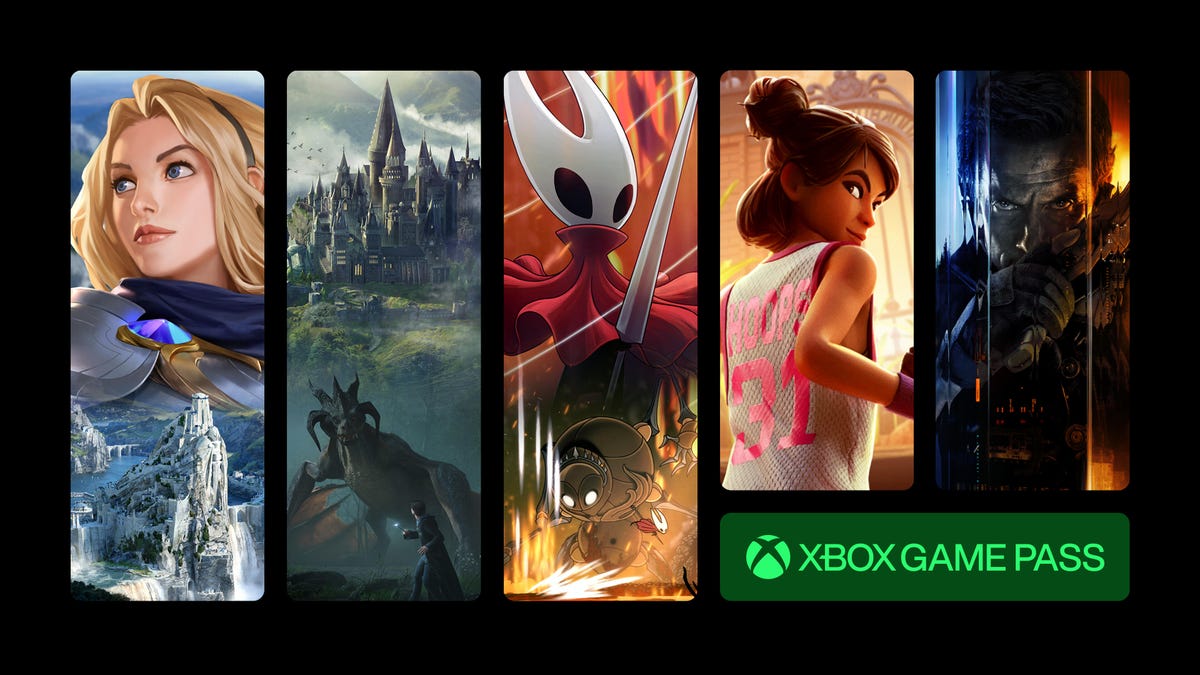
Resident Evil Requiem, the ninth game in the main Resident Evil series, is set to be released on Feb. 26. Xbox Game Pass subscribers can prepare for Requiem by playing Resident Evil Village, the most recent entry in the series, starting on Jan. 20.
Xbox Game Pass offers hundreds of games you can play on your Xbox Series X, Xbox Series S, Xbox One, Amazon Fire TV, smart TV and PC or mobile device, with prices starting at $10 a month. While all Game Pass tiers offer you a library of games, Game Pass Ultimate ($30 a month) gives you access to the most games, as well as Day 1 games, like Call of Duty: Black Ops 7, added monthly.
Here are all the games subscribers can play on Game Pass soon. You can also check out other games the company added to the service in December, including Marvel Cosmic Invasion.
Note: «Handheld» means a game is optimized for handheld play.
Don’t miss any of our unbiased tech content and lab-based reviews. Add CNET as a preferred Google source.
Brews & Bastards (cloud, PC and Xbox Series X/S)
Game Pass Ultimate, Game Pass Premium and PC Game Pass subscribers can play now.
What’s a hero gotta do to get a drink around here? Choose an inebriated hero to travel deep under a tavern in search of the stolen Brew Stone. You’ll explore tavern-themed dungeons and use bar-inspired weapons, like high-caliber champagne bottles, to blast through drunken demons and other boozy monsters. And if you’ve ever called one of your exes a drunken demon, maybe this game will be a little cathartic for you.
Little Nightmares Enhanced Edition (cloud, handheld, PC and Xbox Series X/S)
Game Pass Ultimate, Game Pass Premium and PC Game Pass subscribers can play now.
Little Nightmares is back in high-quality 4K and 60 frames per second in this enhanced edition of the dark tale. You play as a lone child trapped in a massive world inhabited by monstrous versions of adults called the Maw. All you can do is run from these creatures, but you’ll also have to sneak and hide to throw them off your trail if you want to survive.
Atomfall (cloud, console, handheld and PC)
New to Game Pass Premium. Previously on Game Pass Ultimate and PC Game Pass.
The Windscale fire was the worst nuclear disaster in the UK’s history, and it’s estimated that it caused between 100 and 240 cancer-related deaths. Atomfall asks, «What if Windscale was similar in magnitude to the disaster at Chornobyl?»
This game takes place five years after a far more devastating Windscale disaster. You’ll encounter gangs of bandits, cults and rogue government agencies throughout the quarantine zone in the beautiful Lake District, in northern England. It’s up to you whether you avoid conflict or charge into the heat of battle, but resources are scarce, so maybe don’t go in guns blazing every chance you get.
Lost in Random: The Eternal Die (cloud, Xbox Series X/S, handheld and PC)
New to Game Pass Premium. Previously on Game Pass Ultimate and PC Game Pass.
You’re the once-great ruler of Random, Queen Aleksandra, and you’re on a mission of vengeance and redemption in this fast-paced rogue-like game. You’ll fight monsters and beasts with four unique weapons, plus powerful card-based abilities and relics. But death isn’t final here, so if you fall, you’ll return to Sanctuary to rearm, upgrade and prepare for your next run.
Rematch (cloud, PC and Xbox Series X/S)
New to Game Pass Premium. Previously on Game Pass Ultimate and PC Game Pass.
Tackle, dribble and score in this team-based football game (or soccer, depending on your locale). This game was designed for 5v5 online multiplayer matches where players control a single athlete. That means you’ll have to coordinate and plan with the rest of your co-op teammates if you want to win. And with no player stats to give one person an advantage over another, coordination is the key to success.
Warhammer 40,000: Space Marine – Master Crafted Edition (cloud, PC and Xbox Series X/S)
New to Game Pass Premium. Previously on Game Pass Ultimate and PC Game Pass.
You are Capt. Demetrian Titus, an Ultramarine in the Imperium of Man tens of thousands of years from now, and it’s up to you and your squad to help reclaim the Forge World Graia from an Ork horde. Originally released in 2011, this third-person shooter has been remastered for modern consoles with enhanced character models, a modernized control scheme and more. So grab your chainsword and bolter and get ready to fight. For the Emperor!
Final Fantasy (cloud, Xbox Series X/S and PC)
Game Pass Ultimate, Game Pass Premium and PC Game Pass subscribers can play on Jan. 8.
This is the game that started it all. Join the Warriors of Light on a journey to restore power to the Crystals and save their home world. The remastered version of this game introduces enhanced gameplay features, including auto-battle and more, to your screen.
Star Wars Outlaws (cloud, PC and Xbox Series X/S)
Game Pass Ultimate and PC Game Pass subscribers can play on Jan. 13.
Luke Skywalker and the Jedis are cool and all, but who didn’t want to be a cool smuggler like Han Solo? This open-world Star Wars game lets you become just that. You play as Kay Vess, a scoundrel looking for freedom and a new life. You’ll fight, steal and outsmart crime syndicates from around the galaxy. But the Empire is out there, too, so watch your back.
My Little Pony: A Zephyr Heights Mystery (cloud, console, handheld and PC)
Game Pass Ultimate, Game Pass Premium and PC Game Pass subscribers can play on Jan. 15.
Go on an adventure with Sunny, Hitch, Izzy, Pipp, Zipp and Misty as you try to solve a mystery together. Strange music is turning the world upside down, and it’s up to you and your friends to use your powers to put a stop to the music.
Resident Evil Village (cloud, console and PC)
Game Pass Ultimate, Game Pass Premium, PC Game Pass subscribers can play on Jan. 20.
The latest entry in the mainline Resident Evil series puts you back in the shoes of Ethan Winters as he ventures into a haunting European village in search of his abducted daughter. You’ll fight lycans, vampires and other monstrous creatures as you try to uncover why your daughter was taken and your wife was murdered.
MIO: Memories in Orbit (cloud, handheld, PC and Xbox Series X/S)
Game Pass Ultimate, PC Game Pass subscribers can play on Jan. 20.
Get ready to explore a treacherous ship in this sci-fi metroidvania game. You play as Mio, a nimble android who wakes up in the Vessel, a spaceship drifting aimlessly through the stars. The ship’s machines have gone rogue, and vegetation has taken over parts of the Vessel. It’s up to you to figure out what happened to the Vessel and the ship’s purpose.
Games leaving Xbox Game Pass on Jan. 15
While Microsoft is bringing those games to different Game Pass tiers this month, the company is also removing these games from the service on Jan. 15. So, you still have some time to complete your campaign or any sidequests before you have to purchase these games separately.
For more on Xbox, discover other games available on Game Pass now and check out our hands-on review of the gaming service. You can also learn about recent changes to the Game Pass service.
Technologies
We’ve Found the Coolest, Most Futuristic Tech at CES 2026. And the Show Just Started
We’ve already had a day to trawl for our favorite cutting-edge technology. Neat stuff abounds!

We have people all over the show floor and beyond at CES, searching for the most interesting, innovative and cutting-edge tech available. A ton of useful new information is also available, which you can find on our CES 2026 live blog and in our CES hub.
The show floor opened Tuesday, and we had a lot of preview time beforehand to gawk at some CES staples, such as robots, electronic toys, phones and more. I’ll be back here to top off our fun finds regularly throughout the show.
Technologies
Grab This Tariff-Busting Xbox Series X Deal and Save $44 While You Can
You can bag a 1TB Xbox Series X for just $606, but act fast, since we don’t know how long this deal will last.

Ever since tariffs and other economic uncertainty led to Xbox price increases in late 2025, things have gotten expensive. A 1TB Xbox Series X now sells for $50 more than it used to, and there is little sign of these prices improving anytime soon.
Thankfully, every so often, a deal pops up that helps make things a little more affordable like this Walmart discount that slashes that same Series X to just $606. The catch? Well, there isn’t one. But we don’t expect this deal to last for long, so make sure to get your order in soon before it leaves for good.
The Xbox Series X has been around for a while now, so there are no surprises with what you get in the box. The Series X comes with a 1TB SSD for storage, and you get a controller in the box. This version also has a disc drive for installing games and watching Blu-ray movies, too.
Hey, did you know? CNET Deals texts are free, easy and save you money.
You can look forward to watching 4K content and playing 4K games, as well as enjoying audio options such as Dolby Digital, Dolby TrueHD and DTS. All of that makes this a capable machine, whether you want to watch content or play games.
CHEAP GAMING LAPTOP DEALS OF THE WEEK
Why this deal matters
It’s unlikely that Xbox prices will get any cheaper anytime soon, so deals like this are the best we can expect for a while now. If you’re in the market for an Xbox and have the $604 to spare, then this is probably the time to place your order before it’s too late.
-

 Technologies3 года ago
Technologies3 года agoTech Companies Need to Be Held Accountable for Security, Experts Say
-

 Technologies3 года ago
Technologies3 года agoBest Handheld Game Console in 2023
-

 Technologies3 года ago
Technologies3 года agoTighten Up Your VR Game With the Best Head Straps for Quest 2
-

 Technologies4 года ago
Technologies4 года agoBlack Friday 2021: The best deals on TVs, headphones, kitchenware, and more
-

 Technologies4 года ago
Technologies4 года agoGoogle to require vaccinations as Silicon Valley rethinks return-to-office policies
-

 Technologies4 года ago
Technologies4 года agoVerum, Wickr and Threema: next generation secured messengers
-

 Technologies4 года ago
Technologies4 года agoOlivia Harlan Dekker for Verum Messenger
-

 Technologies4 года ago
Technologies4 года agoiPhone 13 event: How to watch Apple’s big announcement tomorrow
